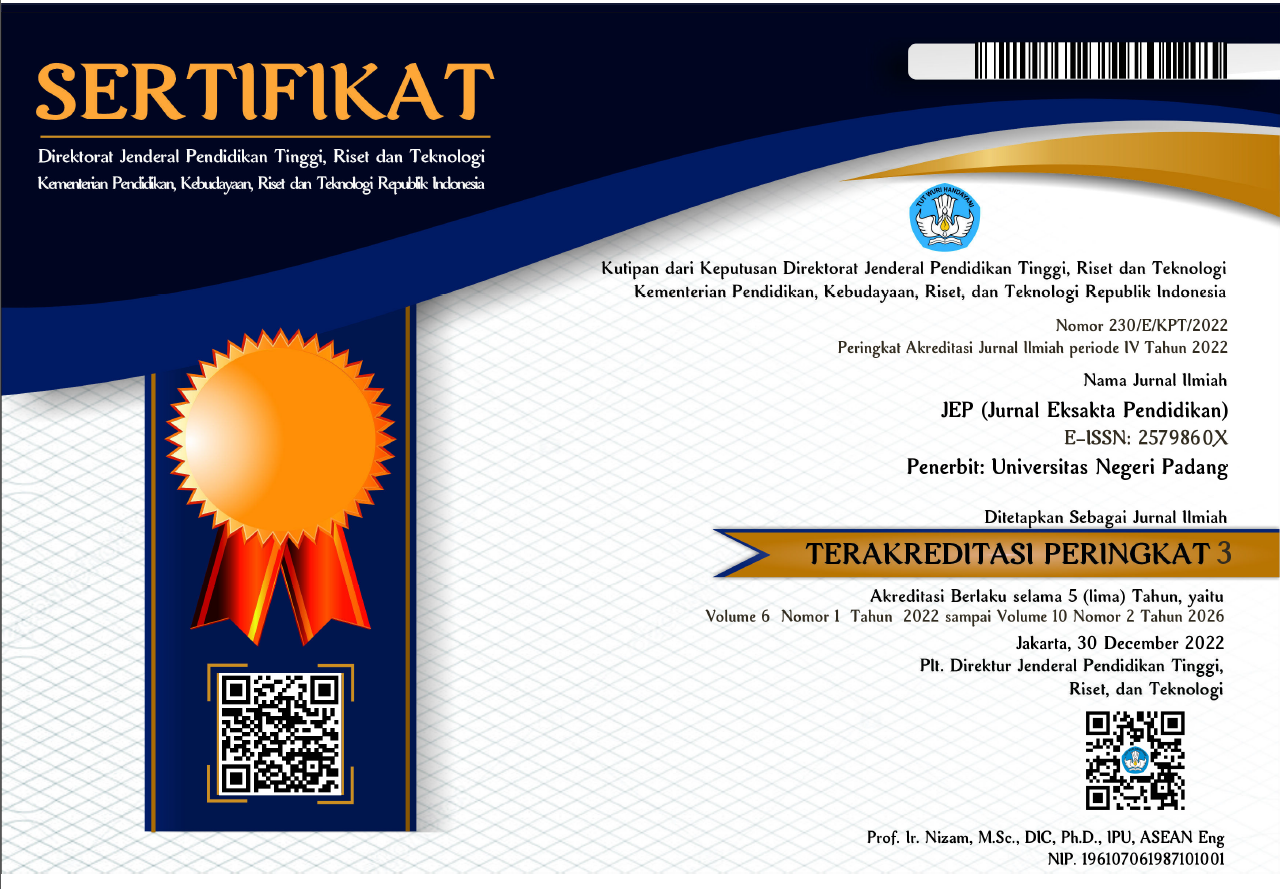Efektivitas Model Pembelajaran ARCSI dengan Pendekatan Saintifik Terhadap Hasil Belajar Matematika Siswa SMP
Abstract
This research is based on the emergence of the 2013 curriculum which expects a learnng process that can make students actively construct their knowledge. The effectiveness of ARCSI learning models with a scientific approach can be seen from student learning outcomes, through 1) Student Worksheets (LKPD), 2) Test of learning outcomes. The results of the study show that the learning model developed is effective when viewed from students' mathematics learning outcomes. The level of effectiveness of the ARCSI learning model with a scientific approach obtained the results of LKIPD grades VII1 SMP N 7 and class VII1 SMP N 1 Ampek Angkek is categorized as effective with a mean of 75.017. The level of effectiveness of ARCSI learning models with a scientific approach obtained from the value of test questions on cognitive learning outcomes is categorized as effective with a mean of 61.38. Based on the hypothesis test for mathematics learning outcomes data can be drawn conclusions, namely: 1) Mathematics learning outcomes of class VII1 students (experimental class) is better than the mathematics learning outcomes of class VII4 students (control class) SMP N 7 Bukittinggi city; 2) Mathematics learning outcomes of class VII1 students (experimental class) are better than mathematics learning outcomes of class VII2 students (control class) Ampek Angkek N 1 junior high school in Agam district
Downloads
References
Bloom, Benjamin S. (1982).Human charac teristics and school learning. New York: McGraw-Hill Book Company.
Cohen, Lauis and Manion, Lavrence. (1990). A Guid To Teaching Practice, London: JEL. Composition, Ltd.
Danim, Sudarwan. (2011). Inovasi Pendidikan: Dalam Upaya Meningkatkan Profesio nalisme Tenaga Kependidikan. Bandung: Pustaka Setia.
Depdiknas. (2009). PetunjukPelaksanaan Pro ses Belajar Mengajar. Jakarta. Depar temenPendidikanNasional.
Kemendikbud. (2014). Bahan Penataran: So sialisasi Kurikulum 2013. Jakarta.
Keller, J. M. & Suzuki, K. (1988). Use of the ARCS motivation model in courseware design. Dlm. Jonassen, D. H. (pnyt.). Instructional Designs for Microcomputer Courseware, Lawrence Erlbaum Asso ciates, Hillsdale NJ, 401- 434.
Keller, J. M. & Suzuki, K. (2004). Learner motivation and e-learning design: A multinationally validated process. Journal of Education Media, 29 (3), 175-189. Tersediapada http//www.arcsmodel.com.Didownload tanggal 14 April 2014.
Keller, J. M. (1979). Motivation and instruc tional design: A theoretical perspective. Journal of Instructional Development 2(4), 26-34.
Keller, J. M. (1983b). Motivational design of instruction. Dlm. Reigeluth, C. M. (pnyt.). Instructional design theories and models: An overview of the current status. Hillsdale, New Jersey, Lawrence Erl baum Associates, Inc., 383-434.
Keller, J. M. (1984). The use of the ARCS model of motivation in teacher training. Dlm. Shaw, K. (pnyt.). Aspects of educational technology: Staff develop ment and career updating, Nichols, New York NY, 140-145.
Keller, J. M. (1987a). Development and use of the ARCS model of motivational design. Journal of Instructional Development 10(3), 2-10.
Keller, John M. dan Thomas W. Kopp.(1987). An application of the ARCS model of motivational design, dalam Charles M. Reigeluth (ed), Instructional theories in action, 289-319. Hillsdale, NJ: Lawrence Erlbaum Associates, Publishers.
Keller, J. M. (1987b). Strategies for stimulating the motivation to learn. Performance and Instruction Journal 26(8), 1-7.
Keller, J. M. (1987c). The systematic process of motivational design. Performance and Instruction Journal 25(7), 1-8.
Means, T. B., Jonassen, D.H. & Dwyer, F. M. (1997). Enhancing relevance. Embedded ARCS strategies vs. purpose. Educa tionalTechnology, Research & Develop ment 45, 5-17.
Mudjiran. (2014). Pengembangan Model Penu gasan Terstruktur Kepada Siswa. Padang: Sukabina Press.
Plomp, T. danNieveen, N. (Eds).(2007). An Introduction to Educational Design Research.Enschede: Netherlands Institute for Curriculum Development (SLO)
Shellnut, B., Knowlton, A. & Savage, T. (1999). Applying the ARCS model to the design and development of computer-based modules for manufacturing engineering courses. Educational Technology, Re search and Development 47, 100-110.
Small, R. (2000). Motivation in instructional design. Teacher Librarian27(5), 29-31.
Undang-Undang RI No. 20 Tahun 2003 Tentang Sistem Pendidikan Nasional, Jakarta: Dharma Bhakti.
Usmadi.(2017). Pengembangan Model Pembela jaran ARCSI dengan Pendekatan Sain tifik. Disertasi Universitas Negeri Padang. Tidak Dipublikasikan.
Visser, J. & Keller, J. M. (1990). The clinical use of motivational message: An inquiry into the validity of the ARCS model of motivational design. Instruct. Science, 19, 2011, 467-599.

This work is licensed under a Creative Commons Attribution 4.0 International License.




_(2579-860X).png)
_(2614-1221)1.png)




